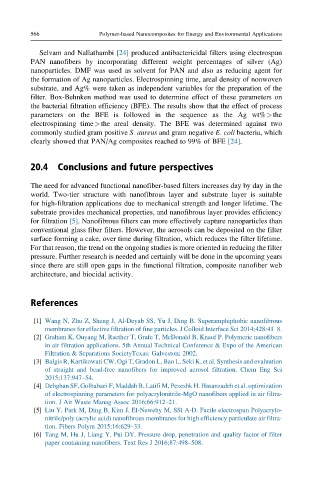Page 613 - Polymer-based Nanocomposites for Energy and Environmental Applications
P. 613
566 Polymer-based Nanocomposites for Energy and Environmental Applications
Selvam and Nallathambi [24] produced antibactericidal filters using electrospun
PAN nanofibers by incorporating different weight percentages of silver (Ag)
nanoparticles. DMF was used as solvent for PAN and also as reducing agent for
the formation of Ag nanoparticles. Electrospinning time, areal density of nonwoven
substrate, and Ag% were taken as independent variables for the preparation of the
filter. Box-Behnken method was used to determine effect of these parameters on
the bacterial filtration efficiency (BFE). The results show that the effect of process
parameters on the BFE is followed in the sequence as the Ag wt%>the
electrospinning time>the areal density. The BFE was determined against two
commonly studied gram positive S. aureus and gram negative E. coli bacteria, which
clearly showed that PAN/Ag composites reached to 99% of BFE [24].
20.4 Conclusions and future perspectives
The need for advanced functional nanofiber-based filters increases day by day in the
world. Two-tier structure with nanofibrous layer and substrate layer is suitable
for high-filtration applications due to mechanical strength and longer lifetime. The
substrate provides mechanical properties, and nanofibrous layer provides efficiency
for filtration [5]. Nanofibrous filters can more effectively capture nanoparticles than
conventional glass fiber filters. However, the aerosols can be deposited on the filter
surface forming a cake, over time during filtration, which reduces the filter lifetime.
For that reason, the trend on the ongoing studies is more oriented in reducing the filter
pressure. Further research is needed and certainly will be done in the upcoming years
since there are still open gaps in the functional filtration, composite nanofiber web
architecture, and biocidal activity.
References
[1] Wang N, Zhu Z, Sheng J, Al-Deyab SS, Yu J, Ding B. Superamphiphobic nanofibrous
membranes for effective filtration of fine particles. J Colloid Interface Sci 2014;428:41–8.
[2] Graham K, Ouyang M, Raether T, Grafe T, McDonald B, Knauf P. Polymeric nanofibers
in air filtration applications. 5th Annual Technical Conference & Expo of the American
Filtration & Separations SocietyTexas: Galveston; 2002.
[3] Balgis R, Kartikowati CW, Ogi T, Gradon L, Bao L, Seki K, et al. Synthesis and evaluation
of straight and bead-free nanofibers for improved aerosol filtration. Chem Eng Sci
2015;137:947–54.
[4] Dehghan SF, Golbabaei F, Maddah B, Latifi M, Pezeshk H. Hasanzadeh et al. optimization
of electrospinning parameters for polyacrylonitrile-MgO nanofibers applied in air filtra-
tion. J Air Waste Manag Assoc 2016;66:912–21.
[5] Liu Y, Park M, Ding B, Kim J, El-Newehy M, SSl A-D. Facile electrospun Polyacrylo-
nitrile/poly (acrylic acid) nanofibrous membranes for high efficiency particulate air filtra-
tion. Fibers Polym 2015;16:629–33.
[6] Tang M, Hu J, Liang Y, Pui DY. Pressure drop, penetration and quality factor of filter
paper containing nanofibers. Text Res J 2016;87:498–508.

